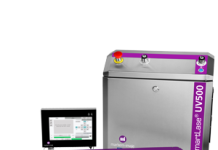Konica Minolta South Africa (KMSA) celebrated National Print Day (NDP) which took place on 28 October 2014. NDP is held every fourth Tuesday in October. On this day, printing companies create an awareness about the true impact that printing has on nature.
NDP focuses on dispelling the myths about print, prove that print is a viable, advantageous and powerful mode of communication. This day advocates print as intrinsic to human nature, evoking emotions and providing a tactile experience.
Very few people know about NDP and KMSA wanted to make everyone aware of the day. The company sent out e-mailers to clients on their database as well as independent data bases.
The email had web links that pointed clients to various sites to get a better picture of the sustainability of paper and that print as a communication media is still a viable tool to use.
Leon Minnie, product manager: production systems at Konica Minolta South Africa, compiled an article about print, its environmental impact as well as that of alternative electronic media like iPADs, tablets and laptops, etc.
Below is Minnie’s feature, ‘iPrint or iPAD?’
Day in and day out, we are faced with messages about the harm that print does to our environment. More often than not, these messages are found at the bottom of emails. Contrary to popular and often misinformed belief though, the fibre used to make paper products is not sourced from the wood of rain forests, indigenous or common garden trees. It is facts such as these that the print industry needs to make known, shredding the misconceptions about print.
Deforestation is a complex and critical problem, with no easy answers; however, printed paper is taking a lot of the blame in the public’s mind for this act. We are told to ‘think before you print’ to save trees and shown pictures of clear-cut forests that sadden and anger us. Maybe it is time to think before we don’t print. The fact is, when the demand for paper declines, tree farming also declines, taking all of the important ecological impacts like clean water and wildlife habitat right along with it. Managed forests also help to clean the air we breathe and offer an improved lifestyle through unmatched recreational opportunities for families who like to hike, fish, camp and study nature. Managed forests do all of this and also provide the pulp we need for paper and packaging.
So, if you decide to decrease your use of paper, don’t think you’re going to save a tree. The reality is that decreasing paper use has an impact on the future of our forests. The truth that most paper is 100 percent recyclable is one of the benefits that makes print on paper sustainable. Recyclability is one of paper’s credentials as a renewable resource that can begin and end its life in a responsible manner. You have a key role in the life cycle of print and paper.
Forests mitigate greenhouse gas emissions by absorbing CO2 and releasing oxygen through the natural process of photosynthesis. South Africa’s timber plantations lock up 900 million tons of CO2 a year, which is a massive environmental service and a key means of mitigating climate change. If it weren’t for the pulp and paper industry operating worldwide for the last 150 years, the CO2 levels in the atmosphere would be five percent higher (about 0.5 degrees) than they are at present.
We all enjoy the instant communication, information and entertainment our computers, smart phones and other electronic devices provide. Each new generation of products brings us even more must-have advantages and marketing strategies, leading to the consumer’s belief that life has evolved in such a way that print or paper is obsolete. But every time a newer, more advanced electronic device arrives, an older one becomes electronic waste with very little benefit. Eventually it will have to be disposed of, and then you have to consider how environmentally friendly this unit was and what harm it will now do to the environment.
While the print industry cannot stop the digital age of communication and its convenience, the electronic distribution of information should not be flaunted as being more environmentally friendly than print. Every decision to communicate has some impact on the environment. For example, whether we email or send a letter, we consume energy and resources. There are environmental trade-offs in every choice we make, and there is no simple ‘right answer’. Effective stewardship requires a careful examination of the bigger picture, one that encompasses the entire lifecycle, from raw materials to energy use and end of life, to fully understand the impact and performance of both electronic media and print on paper.
In fact, reading a document on screen produces more carbon dioxide (CO2) than printing out the same document. A printed document can be read over and over again without further emissions and can also be recycled.
• A 700-page printed document emits 85g of CO2 (one copy can be read over and over again without further emissions).
• Reading it on a computer for one hour emits 226g of CO2 every time.
• Burning the 700-page document to CD is estimated to emit 300g of CO2 for every copy.
• Burning it to DVD is estimated to emit 350g of CO2 for every copy.
Independent campaigning organisation, Greenpeace, has identified electronic waste as the fastest-growing component of the municipal waste steam. Server farms that power computers have become the fastest growing users of fossil fuel in the world, and the amount of energy they use is doubling every year. Also, manufacturing a computer typically requires the mining and refining of dozens of minerals and metals, including gold, silver and palladium, as well as the extensive use of plastics and hydrocarbon solvents. Most computers come from overseas on either ships or planes – the two types of transportation with the greatest carbon footprint. And that’s before they are shipped on trains or trucks domestically.
Domestically produced paper eliminates the overseas shipping energy used, and most of the paper used in South Africa is manufactured here. Over 80 percent of South African plantations are certified by the Forest Stewardship Council (FSC), ranking it as having the highest level of international certification in the world. The FSC’s Chain of Custody tracks certified material through the production process, from the forest to the consumer, including all successive stages of processing, transformation, manufacturing and distribution. Few people realise that all paper in South Africa is produced from plantation-grown trees, recycled paper or bagasse (sugar cane fibre). Some 600 million trees across 762000 hectares are specifically farmed for use in pulp and paper manufacturing, just as maize was planted for our cereal, and wheat for our bread.
The environmental benefits of printed paper
Printed paper is made from a renewable resource. Trees can be replanted in places where they were harvested and also in places where they don’t currently grow. As much as we enjoy our electronic devices, they don’t grow on trees and cannot be harvested.
Printed paper can be recycled, recovered and reused. The systems that are in place for these processes are widely available and have become more efficient and sophisticated over the many years they have existed. In contrast, electronic devices are much more complex and expensive to recycle, recover and reuse due to the toxic nature of many of their components, and current systems are still in the early stages.
Modern commercial printing employs more sustainable practices. From recycling to energy usage, commercial printers are making great strides in reducing their environmental footprints by implementing such practices as:
• Purchasing products, materials and services from individuals and organisations that demonstrate a commitment to sustainability.
• Gaining third-party certification credentials.
• Reducing the impact of chemicals by using vegetable-based inks, eco-friendly soy inks, alcohol-free chemistry and aqueous coatings.
• Using biodegradable packaging materials and waste paper instead of petroleum-based foam peanuts.
• Using a higher percentage of paper grades that are recycled, post-consumer and third-party forest certified to be from responsible sources.
• Educating employees on environmental information, recycling procedures and certification training.
• Equipping presses with ink monitoring devices to reduce waste.
• Recycling printing plates, to name a few.
In conclusion, a future without print or paper would have a devastating effect on society. It can be said however, that it is in everyone’s best interest to embrace this ‘technology’. Think before you don’t print and be responsible with your electronic waste. Use a reputable e-waste recycling company that you know will handle your old electronic devices with the environment in mind.
Konica Minolta South Africa’s award winning bizhub PRESS range of digital printers will keep you printing safe in the knowledge that these machines were manufactured according to the most stringent environmental certification, as well as keeping in mind the environmental influence the company has when disposing of the equipment. These bizhub PRESS devices also use a 100 percent bio-degradable polymerised toner created from harvest plant based oils, which are certified nontoxic when coming into contact with food in packaging. A print technology embracing the environmental benefits of print and paper.
Minnie said that there are many myths about the use of paper and the impact it has on the global environment and that the print industry needs to stand up and make it clear that print is one of the most sustainable and beneficial industries globally.





















